I'm not sure (of all the possible variations) of the semiotics of this image, but I am sure it's not quite the visual message Maestro intended to convey to thousands of East Croydon commuters.
Part of All Request Thursday
I'm not sure (of all the possible variations) of the semiotics of this image, but I am sure it's not quite the visual message Maestro intended to convey to thousands of East Croydon commuters.
Part of All Request Thursday
Posted at 18:06 in Guests | Permalink | Comments (0) | TrackBack (0)
I came across this lovely illuminating piece of type :
around here:
If anyone know what it is/means I'd love know.
Aprat from that, I'd like to point out that the 2012 pin looks gorgeous:
I wish I had one (the lady wouldn't tell me where she got it)
That's it from me www.yonialter.com, thanks Ben
Part of All Request Thursday
Posted at 16:19 in Guests | Permalink | Comments (3) | TrackBack (0)
Ben had 2 rules...argh! That's the 5th headline and intro sentence I've tried.
Ben: I'm gonna have to email you.
Part of All Request Thursday
Posted at 15:54 in Guests | Permalink | Comments (0) | TrackBack (0)
Dear fellow designers,
I need your help in a battle that has raged for over 2 decades...
You see, I head up a studio of 2, attached to a charity. The whole organisation including us are PC based. July is our bi-annual hardware upgrade time, which always brings the old battle to the fore, us Mac loving designers Vs the PC loving director (who is much better in an argument than either of us).
My problem is that my desire for Macs is purely led by my heart, I need to justify it to my bosses brain and balance sheet. So, what I need your help with is some quality, compelling, and hopefully financially beneficial arguments as to why this small part the organisation NEEDS to switch to Macs.
Please, please, help, I know most of you can only begin to imagine my pain, but imagine the difference it will make to quality of life in the studio if I was sat in front of a beautiful Mac rather than this grey box with XP in it.
Just one little comment from you today could make the world of difference.
Part of All Request Thursday
Posted at 15:37 in Guests | Permalink | Comments (18) | TrackBack (0)

I wish you could get transparent post it notes. I'd find them useful
Part of All Request Thursday
Posted at 15:16 in Guests | Permalink | Comments (7) | TrackBack (0)
Who and what inspires me changes constantly, but these are the people influencing me today...
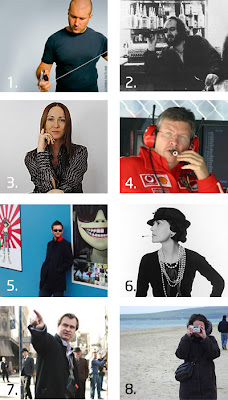
1.
Jonathan Ive, Apple. It's not just that he designs surpisingly
beautiful products, it's that he stuck with Apple through a shitty time
and came out on top
2. Stanley Kubrick. He had the unflinching
support of a major production company. He lived comfortably and
securely with his family around him, yet a short distance from his
work. Completely free to make the best films he possibly could.
3.
Frida Giannini, Gucci. She is slowly but surely bringing the Gucci
brand forward and in to the future. Very intelligent, very stylish.
4.
Ross Brawn, Honda F1. Formerly Tech director at Ferrari and widely
known to be the brains behind their success. Now he has set about
building Honda in to a leading team. I have no doubt he will do it.
5.
Jamie Hewlett. Tank Girl, Gorillaz, Monkey, Phoo Action - all his work,
looks like his own, but each project is totally different from the
last. Comics, Videos, Live performance, Opera costumes the lot.
6. Coco Chanel. She is cool. Look at her. Still looks awesome.
7.
Christopher Nolan. Main stream and still highly intelligent with his
integrity in tact. A very difficult balance to achieve. He seems he is
in total control of his projects.
8. My Wife. I know this is
cheesy, but as much as i like to look at famous people for inspiration,
no one has ever given me as strong a steer through the world as she
has. It's handy living with a genius.
and yours are?
Martyn Reding
jugglingwithwater.blogspot.com
Part of All Request Thursday
Posted at 15:07 in Guests | Permalink | Comments (2) | TrackBack (0)
I was having a look at Sainsbury's Super Naturals range last week. Have you seen it? Gourmet food - nicely packaged, beautifully assembled, apparently healthy - in easy-to-microwave containers. For people who love good food but don't have time to cook. I love to cook, really love to cook, don't buy any ready-meals, always cook from scratch. But when I look at the Super Naturals stuff, I'm tempted to just buy and microwave; it looks so damn good.
And I started to wonder about that "don't have time to cook" thing. Is that really true? Or are we being convinced that we don't have time to cook in order to sell new products?
Posted by Ace Jet 170 as part of All Request Thursday
Posted at 15:01 in Guests | Permalink | Comments (3) | TrackBack (0)
Given this opportunity to write on somebody else's blog - one that actually has a readership - my mind is bombarded with potential subjects to discuss: the joys of sniffing fresh print; how to get a Ffffound invite; the curse of the held-up poster; etc.
But the main thing on my mind is: does Ben Terrett's shadow remind anyone else of Stanley Tucci?
Part of All Request Thursday
Posted at 12:11 in Guests | Permalink | Comments (9) | TrackBack (0)
If you were to be executed,
and you could choose the noose,
would that make it a discretionary ligature?
Adam Poole
Part of All Request Thursday
Posted at 10:25 in Guests, Typography | Permalink | Comments (0) | TrackBack (0)
I'm a designer, but I don't think I'm very good one. I never did art in school, never wanted to either, I don't think I was ever visually perceptive in any way, except for my impeccable sense of style :) But I did love English and received a degree in literature.
I went on to study design having no real understanding of what I was letting myself in for. I soon realised that I needed to be able to draw. I tried hard but I still really struggle with it and when I watch the creative director where I work drawing up quick sketches I just marvel at his ability and flair.
I found that I have always approached problem solving in design in a completely different manner than other designers that I have worked with, just because I have to. Sometimes it's successful and sometimes its spectacularly unsuccessful.
Often I feel like a mathematician who can't add and a complete fraud, yet I have (what I would consider to be) a good job in an advertising agency. I'm just wondering what you 'real' designers think of someone like me, am I the death knell of the designer industry? Or are there room for designers who haven't come from a traditional art and design background?
Marguerite,
Ireland.
Part of All Request Thursday
Posted at 09:53 in Guests | Permalink | Comments (4) | TrackBack (0)
Firstly, thanks to Ben for this opportunity.
Can we make this 'no more solutions day'?
It seems everyone is selling a solution of some kind. There are integrated solutions, corporate solutions, IT solutions, even the bloody ready meals in M&S are called 'hunger solutions'
If you're offering me a solution are you suggesting I have a problem?
Surely we can be more creative than this or is it just what the suits insist on calling their ventures?
If I see another logo called 'solutions this' or solutions that I will explode. No more solutions - let's make this world better!
Cheers
P
Part of All Request Thursday
Posted at 09:52 in Guests | Permalink | Comments (0) | TrackBack (0)
It really is, just to be typing here.
some beholders are blind.
But lately, my mind is thinking more towards design authority.
"Beauty... eye of beholder... yadda, yadda... "
But there are some things that always look good. And some that almost always, don't.
My mind isn't as full of examples at midnight... but there are some principles that good design consists of... and principles that CAN be broken... intentionally---and STRONGLY broken, that can create a provocative, strong design as well...
But those principles (contrast, eyeflow, whitespace, borders, justifications, wise color choice, line length)... they are there for a reason. They help designs be good- er-- well--whatever. They make design better and more effective, webpage, flyer, or buswrap.
And the trouble is, clients, or worse, bosses, can sometimes be more degree-d and trained in business or marketing or whatever, and their position affords them the luxury of coercing you to break those principles for their whim or fancy, or worse yet, for a client's proposal. And not in a strong, edgy, provocative way. In a way that makes you wish you could forget that it was technically your mouse and keyboard, and servitude that made it that way.
Here's to sticking to your guns. design backbone. designing with integrity of principles.
thanks for the wonderful RSS. this lowly designer/ web maintenance guy in Florida has been enjoying the lessons and interesting posts for over 2 years now. keep it up!
Part of All Request Thursday
Posted at 09:50 in Complaints Dept., Graphic Design Industry Stuff, Guests, New Thinking and Ideas | Permalink | Comments (0) | TrackBack (0)
Thinking is for everyone,
but some have to do it a lot.
Designers for example.
If you're like me, always lost
in a non-linear thinking scheme,
this is for you.
Mindmapping is simply a brain
dumping process that helps
stimulate new ideas and connections.
Start with an open, playful attitude...
you can always get serious later
Tiago
Part of All Request Thursday
Posted at 09:48 in Guests | Permalink | Comments (0) | TrackBack (0)
This may well be the maddest idea I've ever had.
For tomorrow only Thursday 28th February you'll be able to post what you want, when you want on Noisy Decent Graphics. That's right I said YOU.
I've set up a generic username (ndgguest) and password (ndgguest). Use this to log in and post what you like. All posts will have to be approved by me before going live so hopefully that will keep you out of mischief. I'm not at work tomorrow so I should be able to approve most things pretty quickly. It will run from 0:00 GMT til 23:59GMT.
Maybe you've always wanted to blog but don't know where to start? Maybe you've got a post or two in you but not enough for a whole blog? Now's the time to get started.
Keep the posts about design, and NO PERSONAL WORK, but other than that there are no rules. If you want to promote your blog, job ad or just slag stuff off then go for it. It would be really great if you could add your name to posts.
I'll say part of that again NO PERSONAL WORK. No one wants to see your 3D web 2.0 renders of the Fed Ex logo. I don't mind you talking about stuff you've done but I don't want it to turn into an online version of an Illustrator's Stock book.
Right, hold tight. You're next.
Posted at 23:03 in Guests | Permalink | Comments (1) | TrackBack (0)
This is the best post I've never written.
I was thinking about Pentagram, Archigram and Magnum and how they've all got similar co-operative style set ups. They're all at the top of their field. They've all got great longevity. And they all end in M, which is probably important.
So I thought I'd write about this.
But the thing is I don't really know enough about all of the organisations. So I asked some experts to write a few words on the structure of each organisation and how that helps contribute to their success. The experts don't need any introduction. A huge thank you to each of them.
You can't help but be inspired and excited by reading all of these texts.
The passion of the protagonists and the power of the collective is evident in each organisation. Investigate further and you'll see that the quality of the work is incredible and consistent.
A few things stand out for me. Firstly they all seem to have been formed out of an honest idea to create amazing work. Secondly they all seem to have come to the same conclusion about the kind of organisation which begets superior work and thirdly that structure has been copied by significantly few others.
So read the stuff below and like me you'll find yourself wanting work in an organistation that pushes the boundaries, puts creative doers at it's heart, where excellence perpetuates and which ends in M.
- - - - - - - - - - - - - - - - - - - - - - - - - - - - - - - - - - - - - - - -
Henrietta Thompson on Magnum
Magnum was a war baby. Founded by four photographers just back from the frontlines in 1947 Magnum Photos resulted from a powerful what-the-hell manifesto, and despite celebrating its 60th birthday last year, its vision is as still just as strong as ever.
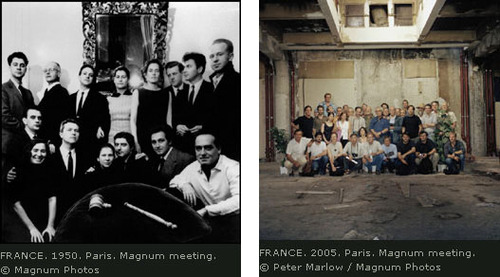
Picture taken from the Magnum website, usual rules apply.
Robert Capa, David –Chim- Seymour, Henri Cartier-Bresson and George
Rodger established Magnum in an effort to change in the way photography
was traded. In order to empower photojournalists to work truly
creatively, without the constraints of demanding managing agents and
editors Mangum made a departure from conventional practice in two ways:
Firstly, the necessary staff would exist to support (rather than
direct) the photographers. Secondly, the authors of the imagery held
the copyright - not the magazines, so if a photographer was published
in Paris Match, Magnum could still then sell the same photographs to
Life magazine, say, or the Picture Post. This meant that the
photographer would gain the means to work on new projects even without
an assignment. More importantly, it meant that photojournalism would be
recognized as the artform it was.
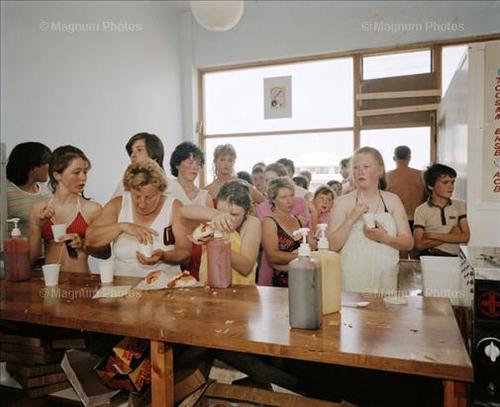
Picture by Martin Parr, taken from the Magnum website, usual rules apply.
With the flexibility to choose their own stories (and to work for long
as it took to get the right shot) the photojournalism being processed
by Magnum was – and is still – very different to that of a photographer
on commission: there is a point of view to the stories that goes far
beyond the purposes of event recording. “We often photograph events
that are called 'news' ," Cartier-Bresson told Byron Dobell of "Popular
Photography" magazine in 1957, " Life isn't made of stories that you
cut into slices like an apple pie. There's no standard way of
approaching a story. We have to evoke a situation, a truth. This is the
poetry of life's reality."
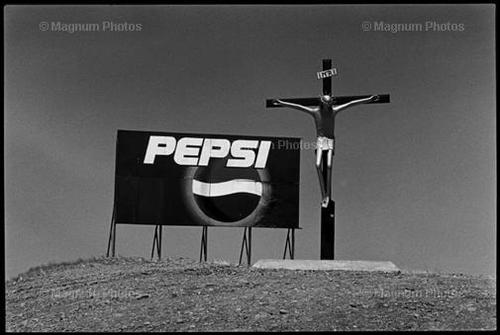
Picture by Elliot Erwitt, taken from the Magnum website, usual rules apply.
Magnum today is still such a cooperative, operating from offices in
London, New York, Paris and Tokyo - and providing photographs to the
world’s media, galleries and museums. It is entirely owned by the
photographers it represents and , if you see an iconic image of any
significant world event since the Spanish civil war and are not sure
who took it, chances are it was a Magnum photographer.
- - - - - - - - - - - - - - - - - - - - - - - - - - - - - - - - - - - - - - - -
Michael Bierut on Pentagram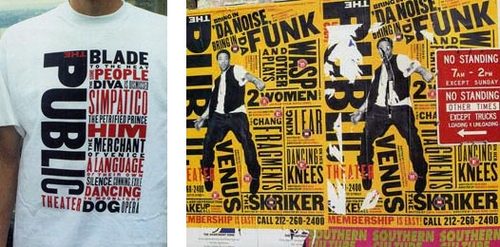
The Public Theater, New York identity by Pentagram, usual rules apply.
Pentagram's
structure is based on a few simple principals. First, the first is
structured around its partners, each of whom runs an autonomous team of
designers who are dedicated to working on that partner's projects. This
is meant to replicate the creative intensity of a small design office,
where everyone is focused on the work. Second, all of the partners are
designers. There are no partners who are managers, or strategists, or
account people. That means that while money is important -- the
partners have to be good businesspeople, after all, since they can't
pass that responsibility off -- the attention of the firm is on design,
not money.
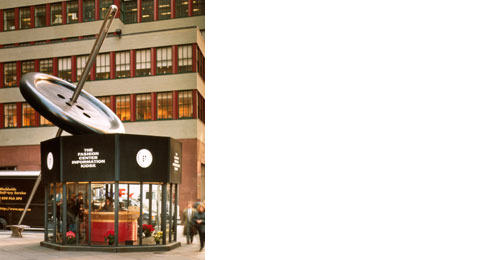
The Fashion Center information kiosk by Pentagram, usual rules apply.
Third, the partners are all equal, regardless of seniority. Finally, the partners are diverse. There are architects, product designers and new media designers along with the graphic designers, and even the graphic designers have wildly divergent styles. This means that there are many advantages in working collaboratively.
These principals are surprisingly unchanged since firm's founding in 1972. I think they've guaranteed a certain amount of stability, a longstanding commitment to good design, and slow but steady growth.
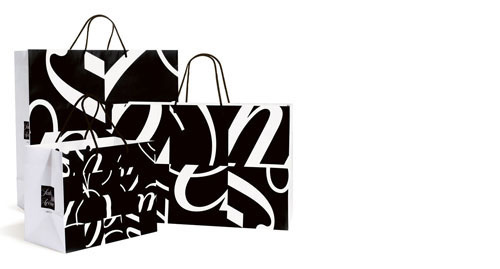
Saks Fifth Avenue Identity by Pentagram, usual rules apply.
- - - - - - - - - - - - - - - - - - - - - - - - - - - - - - - - - - - - - - - -
Dan Hill on the "Archigram - What - Organisation - You - Must - Be - Joking - Mate"
The bare facts are these. Six youngish men come together in various flats in Hampstead, London, in the early 1960s. They produce a magazine-like publication Archigram, that lasted from 1961 to 1970 (roughly), and the firm that had grown out of it Archigram Architects, lasts until 1975. 900 drawings are produced along the way, yet assessed In terms of built projects they produce only a playground in Milton Keynes and a swimming pool for Rod Stewart. If that. And yet they influence architecture profoundly. Their work is the thing, and should be pored over time and time again (see refs. below), but the question here is whether their organisational structure aided this extraordinary state of affairs.
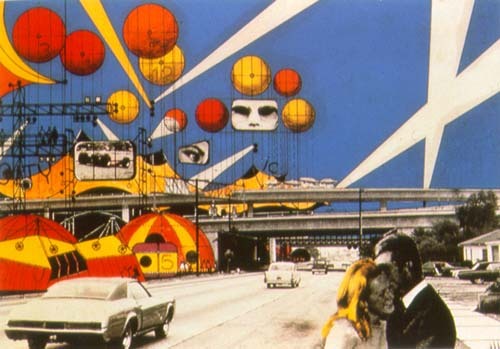
Archigram pictures from all over the place, usual rules apply.
The 'rock group' motif attached to Archigram is a little overplayed - generally the analogy goes they were "the Beatles of architecture", a lazy comparison based around their perceived insouciance, iconoclasm and psychedelic visuals, exploding out of a then-stuffy trade. "A necessary irritant" as Barry Curtis called them. Firstly, they were of course far better than the wildly overrated Beatles. (Even musically: in the retrospective at the Design Museum a few years ago, the visitor was confronted with The Yes Album playing, from a messy mock-up of their studio, but it really should've been Ornette Coleman and Albert Ayler.)
Secondly, the key point of difference is that they heavily influenced without making buildings. Could a band influence as much without releasing a record? In this, they were part of a tradition of un-built but visionary work that makes architecture and urbanism almost unique in design practice. So what set them apart was the publishing.
That espoused a take on modernism informed by a generally positive reaction to the technology and media that had which emerged, with necessary inventiveness, from WWII, a conflict that was still front of most people's minds, self-evident in the half-shattered cities around them. This optimism and invention is then allied to the 'post-scarcity' culture that emerges in the late-'50s, as they cut and paste the space race onto colour telly and pop-art and planned obsolescence, spray-painting structural engineering with beat poetry and Harold Wilson's 'white heat of technology', fusing Monty Python montage into avant-garde internationalist happenings in, wait for it, Folkestone. In pursuing the unbuilt, ephemeral, temporary and informational, they are precursors for a version of the 21st century (at least the one unaffected by peak oil).
Their proposals for Instant, Walking or Plug-In Cities, Suitaloons and Living Pods, were radical, fluid, malleable, intimate and transient - "tune up, clip on, plug in" into "rooms (that) expand infinitely. Our walls dissolve into impermeable mists or into the imagery of stories and fables ...".
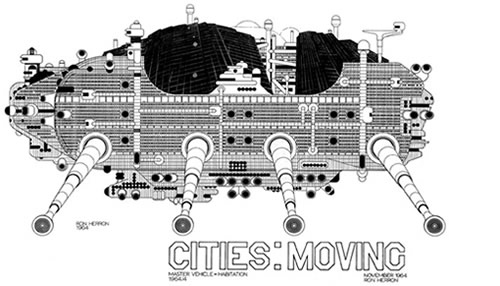
The Walking City by Archigram. Pictures from all over the place, usual rules apply.
Yet their own structure remained relatively solid. If not the band, the architectural practice was essentially their recognisable model, though that is usually just as rife with splits, egos, and partners flouncing out over non-musical differences. There seems to have been little of that in Archigram's dissolution. Only that a large scheme in Monte Carlo fell through, and their fabric couldn't stretch over the distance from Folkestone to Los Angeles, which is a long way geographically but even further culturally.
So there's a disparity between their projects - "an architecture that twitched ... was responsive to people" - and their own structure. Certainly, it seems to have been fairly disorganised. Reyner Banham called them, the "Archigram-What-Organisation-You-Must-Be-Joking-Mate". But no more so than for many other architects.
The two groups of three came together to form six (three out of the art schools, and the other three working at the innovative London County Council). In a recent interview, the group's Peter Cook listed their roles:
" I was the enthusiast. Mike Webb was the genius. Ron [Herron] was the fantastically fluent member. Warren [Chalk] was the warrior. David [Greene] the poet. Dennis [Crompton] was the technologist. And I was the beaver, the operational person. Everybody overlaps, but that's the simplified version."
So we see the specialist-meets-multidisciplinary brew common to many micro firms. Though they were all essentially trained in the same master discipline, Cook points out they ranged over 10 years in age and came from different schools - "There was a hint of internal competitiveness. So it was rather like a studio in a college would be—looking over the shoulder of the other and thinking, "That's interesting, now I must do something, too."
The fact they were rarely troubled by praxis may have enabled the six-person team to remain six - to attempt to build much of what they proposed would have inevitably meant a certain fraying at the edges, as this highly complex work now tends to involve numerous specialists. Plus of course the messy necessity of clients. Firms actually approaching their ideas in built form these days - arguably OMA/AMO, Arup, MVRDV, Foster, Rogers, Herzog + De Meuron, Future Systems, Morphosis and Atelier Bow Wow perhaps - are larger, highly diverse, often corporate structures.

Archigram pictures from all over the place, usual rules apply.
But as an ideas generator, this 6-person team of occasionally spiky, overlapping semi-specialists, unified by a single trade, medium and sensibility, was immensely productive. Given that medium was publishing, and their trade ideas, it was also immensely flexible. They took to heart the maxim, perhaps after Cedric Price, that "when you are looking for a solution to what you have been told is an architectural problem - remember, the solution may not be a building."
Cook, the most vocal member today, is slippery on who was actually in the office, doing what. But also notes that the "untidy structure", as he called it, meant they've never really stopped as well. As they transcend a firm and become more of a genre, they become less of an organisation and more of an idea.
If we can get that fluid with things, a key part of their organisation not often articulated might be the umbrella. In a sense, they were part of an un-named and equally loosely-aligned multidisciplinary movement, with Cedric Price, Eduardo Paolozzi, Richard Hamilton, James Stirling, Buckminster Fuller, Reyner Banham and The Smithsons hovering over the group as some kind of unlikely beneficent chorus. Other firms or movements, such as Italy's Superstudio, Japan's Metabolists, fore-runners Team X, are also part of this scene. In this, a fluid membrane of intellect surrounded the group, through which ideas could be tested, progressed, translated or deleted. A jellyfish-like structure comes to mind, a translucent, flexible dome of thinking, floating over a smallish core body.
This was not a formal organisation at all - barely even a movement, just partly-shared sensibilities - but enabled a rich loam for fertilising ideas, and created a purpose and direction for the work. It's difficult to see equivalents today. Might this layered umbrella structure be the important factor? They might have called it the 'organisation gloop'.
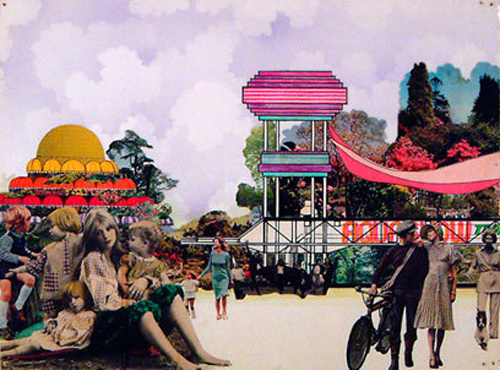
Archigram pictures from all over the place, usual rules apply.
Cook asserts "the strength of Archigram was surely its layers of inconsistent parts, keeping going a continual fascination with each other. " So within the gloop, this fascination holds the core. It's almost no more than a sudden freeze-frame on a longer timeline, a group of people coalescing around a way of thinking, as much as doing. They were a purely informational organisation, as close to media, marketing, branding, banking or academia as to architecture, as was their work.
So perhaps the essence to extract from Archigram's organisation was not in their own structure, but in the structure of the buildings they proposed - an organisation that twitches, is responsive to people; an organisation that coalesces, exists briefly, and then is gone, existing only in time; organisations that can expand infinitely, or dissolve into stories and fables; organisations in which the function can switch fluidly; organisations with a permeable skin ... Really, you could take Archigram's work and find and replace the words 'built environment' or 'architecture' or 'city' with the word 'organisation', and that would give you a truly innovative structure indeed.
- - - - - - - - - - - - - - - - - - - - - - - - - - - - - - - - - - - - - - - -
References:
Archigram
Archigram.net
Archigram [Wikipedia]
Concerning Archigram - Dennis Crompton (ed.)
Archigram - Peter Cook (ed.)
Archigram: Architecture without Architecture - Simon Sadler
Interview with Sir Peter Cook [Architectural Record]
Pentagram
Pentagram Design
Paula Scher's Family Of Men diagram / video
Pentagram Blog
Pentagram [Wikipedia]
Once again, that was pretty good, wasn't it?
I'd like to say a really big thank you to Mike, it takes a lot of effort to write that much original stuff. I gather from the comments that he was a big hit, and quite right too.
I really like these Guest Weeks. It give the blog a different feel and it seems to bring a slightly different audience, it raises different issues. Personally I loved the writer/designer stuff, I like the copywriters look at the ad and it was interesting to see a different point of view on the never ending webpage. It was great to see the Puttnam review too. All really good stuff.
Thanks to everyone for commenting ad making him feel welcome.
OK, now back to normal.
Posted at 23:27 in Guests | Permalink | Comments (3) | TrackBack (0)
That's it from me, I think. I have a couple of urgent things to get done before what clients insist on calling COP, and I don't have any more Post Idea Post-its on the wall.
I've had a great time playing with Ben's blog, and I hope it's been of some use and pleasure to some of you. Thank you very much to everyone who commented - it's strangely thrilling, and rather addictive, checking the comments sections. I'll miss our little chats.
Thanks also to to everyone who emailed me with their views on The Great Writing And Design Debate. I don't think we've solved anything major, but I think I've done a little bit to encourage some dialogue. (Special thanks to David for his kind encouragement.)
I'd have liked a bit more input from the writers, if I'm honest. I think many of my own niggles about the lack of writer/designer collaboration are shared by others, and I thought they'd jump at the chance of a little ding-dong with the "design community". Thanks to those that did, but I wonder if maybe Tim's right.
As if this week hasn't been self-indulgent enough already, I hope you won't mind if if I end with a lttle bit of PR for a favourite cause. Having this temporary soapbox is too good an opportunity to miss.
Quite by fluke, I became the UK's first member of 1% For The Planet a few years ago. This is an association of businesses that each give at least 1% of their income (not profits) to environmental causes. It was set up by Yvon Chouinard, founder of Patagonia, and the membership is growing all the time. The last I heard, the average was one new member every day.
It would be great if this blog resulted in a new member or two. So do have a look at the 1%FTP site, and see what you think. You know it makes sense.
Thanks for listening, and biggest thanks of all to Ben for trusting me with the reins. Cheers everybody.
Mike
Posted at 15:43 in Guests | Permalink | Comments (8) | TrackBack (0)
Facebook is kind of the reason I'm here. Ben and I are Facebook friends, and one day I wrote a random little status thingy about liking Amy Winehouse. Ben likes Amy too, and dropped me a note. We had a little chat, and he suddenly said, 'Do you fancy doing the blog for a week?' And here I am. That's 21st Century networking for you.
Except it seems like it may not be for long. There's this row about Beacon, an advertising initiative that tracks your online purchases and then sells targeted ads on Facebook. Rather creepy. (50,000 users signed a petition against it, which shows the kind of near-instant people power you can generate online.) And apparently the Facebook bosses have been handling it all very badly and everyone now hates the site. (I have to say, I hadn't realised.)
I just thought this was all rather interesting. And as it's tangentially relevant to my presence here, I thought I'd pass it on.
Posted at 13:08 in Guests | Permalink | Comments (4) | TrackBack (0)
I almost gave up trying to get to London for the talk last night. (I live in leafy Surrey.) I was running late anyway, and then the train was delayed. I wasn’t sure I’d make it. But I’m glad I persevered, because it was terrific. I hope you won’t mind a bit of a ramblog abut it.
I only missed the first few minutes, and arrived to find Lord Puttnam in the midst of an argument about the role cinema can play in shaping people’s understanding of the world. By the time he got to the issue of climate change, he’d created a forceful theme about personal responsibility. He also drew what I thought was a brilliant analogy with the slave trade. Indulge me while I pass it on, won't you?
Until it was abolished in 1807, slavery was a key economic driver - just as traditional energy sources are now. So, just as now, plenty of business people were up in arms about any suggestion of change. But in just the same way, the true cost - the human cost - was deferred onto people who didn’t have the power to speak up. Today, that's people in places like Bangladesh, Africa and Central America already feeling the devastating effects of climate change. As long as we’re not paying the price, we look away.
The positive side of the story was that, according to Puttnam, abolishing slavery actually created enormous growth in the economy. It turned out slavery was actually holding the economy back. Getting rid of it unleashed huge ingenuity, creativity and innovation. The parallels with today’s energy situation are striking indeed.
As you can tell, it was a broad-ranging talk, but the theme of communication ran through it all, which is why I’m telling you about it. Puttnam regards climate change with the sort of grave concern it very obviously deserves. And he spoke passionately about the need to communicate the urgency of the message to all. Naturally, he focused on TV and cinema, but the single example of a great communication he actually quoted was a strapline. It was the slogan of the MIT team working on the carbon neutral car (which I'm guessing is this one). Their slogan is:
We are the people we’ve been waiting for.
That got a warm, delighted ripple of laughter and nodding from the audience, and quite right: it’s brilliant, isn’t it? No doom and gloom. No hand-wringing. Just a thoroughly positive - dare I say empowering? - line that says a great deal in eight simple words.* It’s kind of the antithesis of the Neilson poster. (Google informs me it's a quote from a poet and activist called June Jordan.)
There was another moment in the evening that highlighted the power of words. Someone in the audience suggested that the phrase "the environment" was unhelpful. "The environment" feels like something separate from us, something "over there". Instead, this chap suggested, we should call it "our environment", making it immediate and personal for everyone.
That, too, got a little round of applause – and a pledge from both Lord Puttnam and the President of the RSA that they would henceforth always refer to "our environment". I liked the idea too, so I’ll be trying to stick to that construction in future. Of such tiny changes are revolutions made.
It’s moments like this that remind you how much power we have in the communications business. Not just with words, but with all the tools we use - visual, verbal, strategic, conceptual - to get big ideas across to big audiences. Most of us put most of our energy into getting clients’ ideas across, and there’s no shame in that. But when you imagine what we could achieve on an absolutely critical issue like climate change, just by turning our guns in that direction, you wonder why we’re not doing a very great deal more of it already. (All credit to initiatives like Green Thing, Applied Green, and so forth.)
-------------------------------------------
* Quite separately, my favourite one-great-headline story is told in Robert Evans’ autobiography, The Kid Stays in the Picture. Evans, like Puttnam, was a movie producer (The Godfather and Chinatown, not a bad record). In 1969, he was struggling to sell the film Goodbye, Columbus to distributors. It was the story of a middle-class Jewish family, and this was the counter-culture 1960s: no one wanted to know. Evans had no marketing budget, so he cut a deal with Steve Frankfurt, then the young firebrand creative head of Y&R.
Frankfurt said he’d write them a poster for nothing. But if Evans decided to run it, he wanted $100,000. This is in 1969, remember. The poster Frankfurt presented carried the line, Every father’s daughter is a virgin. It resonated hugely with Sixties parents. Like the MIT line, it says a lot in very few words. And it worked – although it must be said, it worked very small on a very big image of Ali McGraw. (Words and design together again.) The picture was a hit. And Steve K got his $100K. Not bad for a poster.
Posted at 10:23 in Guests | Permalink | Comments (3) | TrackBack (0)
James, a studio copywriter whose full name I'm keeping secret for obvious reasons, writes in about the not-uncommon bias among many clients to see design as the "creative" bit.
"There's this cultural prejudice amongst our clients that all the really exciting ideas only come from the designers. It's even an attitude exhibited by some of the designers themselves - they jealously guard their ideas, still coming up with brilliant work, it's fair to say, but then asking me to "drop in" some great copy at the last minute to fit."
I was putting together a post on this anyway, so it's good to have my thoughts corroborated, James. If clients are reinforcing the notion that writing can simply be tacked on to the "creative", that must be another reason writers get left out of the concept stages, mustn't it? Even if a design consultancy wants to bring in a writer early, it's not very helpful if the client is saying, "No, just get them in once everything else is approved."
This isn't just sour grapes, by the way. I honestly believe you get a much stronger, more cohesive piece when writer and designer work closely together from the outset.
James didn't just want to rant, however. (Which is good, as I seem to be doing rather a lot of rant posts this week. Sorry about that.) He goes on:
"The more positive view is that there are other designers who are much more open and collaborative, and it's the work we produce together that has the legs on everything else. As you say, it's when you sit down together, share ideas and knock things back and forth that it works best. It's also this teaming approach, following the advertising model, which is slowly chipping away at the stale views held about the role of words and copywriters in general."
I hope, and believe, you're right, James.
Posted at 14:28 in Guests | Permalink | Comments (0) | TrackBack (0)
Recent Comments